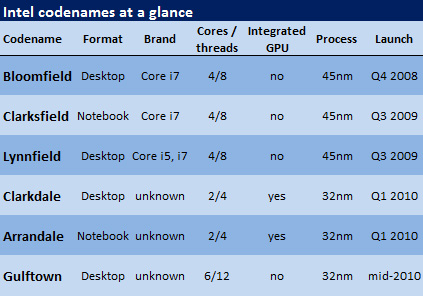Intel's 2010 roadmap

Intel's roadmap for the next 12 months, presented at IDF in San Francisco, includes a gradual transition to a 32-nanometer (nm) manufacturing process, the first CPUs with integrated graphics processing and a six-core processor for desktops.
But the chip giant has even more ambitious plans: in the course of 2010, Intel will launch the Larrabee chip, whose first incarnation in the form of a discrete 3D graphics card should provide competition for ATI and Nvidia. A little further down the line, towards the end of 2010 or early 2011, we'll see a new architecture in the shape of Sandy Bridge.
On the following pages, we provide an overview of Intel's upcoming developments in desktop, notebook, netbook and graphics processors.

Clarksfield: Nehalem comes to the notebook
Clarksfield — officially called Core i7 — brings Intel's Nehalem architecture to notebooks. The main features of Nehalem, introduced in November 2008, are an integrated memory controller and hyperthreading.
All Clarksfield chips have four computing cores and can handle eight threads simultaneously thanks to hyperthreading (2 threads per core). To achieve a thermal design power (TDP) of between 45W and 55W, Intel has had to reduce clock speeds significantly. Desktop Nehalems run at between 2.66GHz and 3.33GHz, while their notebook counterparts can only manage 1.6GHz to 2GHz.
However, clock speed in this case is less significant than at first sight. Like their desktop equivalents, the mobile Core i7 CPUs have Turbo Boost technology. Temperature permitting, the processor can overclock a single core to a specified maximum frequency within its TDP parameters. Furthermore, the maximum extra from Turbo Boost for Nehalem desktop chips is up to 640MHz, whereas Clarksdale chips can get to up to 1.2GHz beyond their usual clock speed.
This extra speed is particularly useful for applications that are not optimised for multithreading. Until now, such applications have run slower on quad-core chips than on dual-cores. Intel aims to use Turbo Boost to remove this problem.
But a few issues remain with Turbo Boost. When, how often and for how long cores are overclocked depends on operating temperatures. So a poorly-cooled notebook will achieve a lower maximum clock speed.
Clarksfield, together with the PM55 chipset (a descendant of the P55 used on the desktop), constitute the Calpella platform. Calpella will not be marketed under the successful Centrino brand that has served the five previous mobile platform generations. Stickers on the new notebooks will only mention Core i7. But Centrino will not disappear entirely: the name will survive in Calpella's wireless LAN module.
Like the desktop chips, Clarksfield is produced using 45nm manufacturing. A switch to 32nm technology is not yet on the cards for these mobile quad-cores. That step takes place only with the next architecture, which is called Sandy Bridge. All 32nm CPUs with the Nehalem architecture are part of the Westmere family.
Arrandale and Clarkdale: 32nm dual-cores with integrated graphics
Although Intel talks almost exclusively about its quad-core chips, the company's dual-core processors are far from obsolete. The successor to the Core 2 Duo series is already waiting in the wings. Desktops with the Clarkdale chip and the first notebooks with Arrandale will probably appear early in the first quarter of 2010.
Clarkdale and Arrandale are the first chips from Intel to be manufactured using the 32nm process. These dual-cores are based on the Nehalem architecture and can handle four threads simultaneously using hyperthreading (2 threads per core). The graphics processing unit (GPU) is housed in the processor package, but not on the same piece of silicon. Until now, the GPU has been part of the chipset rather than in the processor package itself. The GPU will still be manufactured using the 45nm process.
Intel has yet to announce clock speeds for Arrandale and Clarkdale, but it has made clear that both CPUs will have Turbo Boost — which in the case of Clarkdale will even extend to the GPU.
A Clarkdale chip shown at shown at the Intel Developer Forum (IDF) in September was clocked at 3.33GHz and needed only 24W in idle mode. By comparison, a 2.33GHz Core 2 Duo with GMA 950 graphics from Fujitsu Siemens used 45W.
First benchmarks: Clarkdale outstrips Core 2 Duo
At September's IDF in San Francisco, Intel published the first performance figures for the Clarkdale 32nm processor. In the PC Mark Vantage and 3D Mark Vantage benchmarks, Clarkdale significantly outperforms its predecessor, the Core 2 Duo, according to Intel's figures.
The tests used a 3.33GHz Clarkdale, a 3.16GHz Core 2 Duo and a 2.66GHz Core 2 Quad. The Clarkdale processor has its GPU integrated into the processor package, whereas the Core 2s were tested using Intel's latest GMA X4500HD graphics chipset.
In both benchmarks, Clarkdale shows its clearly superior graphics processing. This edge is particularly apparent in the 3D Mark Vantage test (above), which measures 3D performance. It also shows that Core 2 Duo and Core 2 Quad are more or less on a par in this area. Clarkdale also beats the Core 2 Duo in the CPU benchmark, thanks to its revised architecture and hyperthreading, but narrowly loses out to the Core 2 Quad in this test.
A similar picture emerges from the PC Mark Vantage benchmark, which tests performance using a whole range of applications. The Core 2 Quad's chipset, GPU and lower clock speed limit its performance.
Of course, manufacturer benchmarks should be taken with a pinch of salt. For example, in practice the quad-core would be unlikely to be used with a graphics chipset known for its slowness if it were running graphics-intensive applications. So the picture is somewhat distorted.
Nevertheless, we can certainly expect the new Clarkdale to offer significant performance advantages, especially over the Core 2 Duo. ZDNet will be carrying out its own tests on these chips as soon as they become available.
Six-core Gulftown is Nehalem's successor
The Core i7-800 and Core i5-700 Lynnfield processors bring Intel's Nehalem architecture to the mass market. The number of memory channels has been reduced from three to two. The new Core i5 and Core i7 CPUs no longer fit the previous LGA-1366 socket, but require the new LGA-1156. A new chipset, the P55 Express, complements the Lynnfield CPUs.
Anyone who has bought a system with the Nehalem X58 Express chipset will get a powerful upgrade option in mid-2010 in the form of the six-core Gulftown, which is part of the Westmere family. With its 130W TDP, Gulftown will run in any Nehalem board after a BIOS upgrade. Intel has not yet revealed clock speeds for the hyperthreading-enabled Gulftown, but it was demonstrated in action at September's IDF.
The Gulftown chip has six cores and hyperthreading, and belongs to the Westmere family. The system shown here is rendering an image while simultaneously playing an HD video. Photo: ZDNet Germany
Sandy Bridge architecture scheduled for end 2010
Intel unveiled Nehalem as the successor to the Core 2 architecture in November 2008. Its main innovations are the integrated memory controller, hyperthreading and improved virtualisation. The upcoming Arrandale, Clarkdale and Gulftown chips are 32nm versions of this architecture, with only small improvements, such as an integrated PCI-Express port and hardware-accelerated AES encryption.
At the end of 2010, once Intel has gained sufficient experience with the 32nm process, the chip-maker will introduce a new microarchitecture, codenamed Sandy Bridge. The appearance of a Sandy Bridge machine at IDF suggests that the technology is progressing well. The system ran Windows 7 and used Windows Movie Maker to edit a video. Intel provided no indication of clock speed.
Details about Sandy Bridge are sparse, but it's known that the 32nm chip will have the Advanced Vector Extensions (AVX), an instruction set that will bring significantly more power to the execution of multimedia tasks. Sandy Bridge variants will have the GPU either in the processor package or integrated on the die. In addition, Intel is promising a major overhaul of the graphics core.
Larrabee: can Intel catch ATI and Nvidia?
Intel's graphics chipset may be power-efficient, but it lags far behind rival products from ATI or Nvidia in terms of performance. When it comes to discrete graphics chips, Intel is nowhere — at least for the moment. That situation should change with the arrival of a chip called Larrabee, which the company has been talking about for some time (if you read German, ZDNet Germany has already examined the architecture in detail).
Larrabee is a chip with 24 or more x86 cores, which have been expanded to include hyperthreading, 64-bit capability and a new SIMD architecture. These characteristics create a chip capable of carrying out tasks in parallel, such as encoding videos, flow calculations and other scientific and technical applications.
ATI and Nvidia also want to strengthen their positions in this lucrative field, but programming their GPUs remains relatively complex and inflexible, despite significant improvements in recent years. The Larrabee concept enjoys one significant advantage: according to Intel, Larrabee also offers the ability to implement various 3D pipelines, such as Direct3D, OpenGL and raytracing.
There is much debate about whether Intel's architecture is capable of catching up with ATI and Nvidia, and several delays to the project have raised further questions. Many participants at IDF expected a clear signal about Larrabee's future. There was indeed a first — albeit unimpressive — demo, but no technical details were forthcoming.
Nevertheless, Intel used IDF to repeat its position that it would be producing a range of discrete graphics cards by the end of 2010. The company said there was no change of course or repositioning of the project for scientific applications. But doubts remain about Intel's ability to compete with the dominant forces in graphics hardware.
Pineview: Atom's successor
The successor to the Atom processor, Pineview, was not a big issue at IDF. However, it should come out this year. Recently, Intel executive Mooly Eden discounted suggestions that the introduction of Pineview would delayed until 2010.
The Pine Trail platform consists of a Pineview CPU, a GPU and a memory controller on the same die. Only the I/O hub will remain as a separate chip. Intel has given no further details.
Conclusion
Intel has presented a robust CPU roadmap for the next 12 months. Even if the respective variants are not yet known, the 32nm chips Arrandale, Clarkdale and Gulftown are expected to arrive on time. Also the demo of Sandy Bridge is a good sign.
Larrabee is also expected to become Intel's entry into the discrete 3D graphics chip market in 2010. The GPU has now been publicly demonstrated, but the lack of technical details casts some doubt on the success of the project.